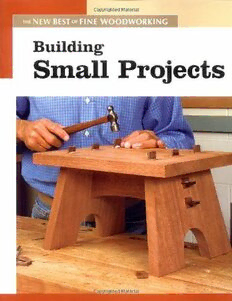
Building Small Projects: The New Best of Fine Woodworking PDF
Preview Building Small Projects: The New Best of Fine Woodworking
NEW BEST FINE WOODWORKING THE OF Building Small Projects THE NEW BEST OF FINE WOODWORKING Building Small Projects NEW BEST FINE WOODWORKING THE OF Building Small Projects The Editors of Fine Woodworking T © 2004 by The Taunton Press, Inc. Photographs © 2004 by The Taunton Press, Inc., except where noted. Illustrations © 2004 by The Taunton Press, Inc. All rights reserved. Pp The Taunton Press, Inc., 63 South Main Street, PO Box 5506, Newtown, CT 06470-5506 e-mail: [email protected] Distributed by Publishers Group West Jacket/Cover design: Susan Fazekas Interior design: Susan Fazekas Layout: Susan Lampe-Wilson Front Cover Photographer: Asa Christiana Back Cover Photographers: Asa Christiana, Michael Pekovich, Strother Purdy The New Best of Fine Woodworking® is a trademark of The Taunton Press, Inc., registered in the U.S. Patent and Trademark Office. Library of Congress Cataloging-in-Publication Data Building small projects / the editors of Fine woodworking. p. cm. -- (The new best of Fine woodworking) ISBN 1-56158-730-8 [book]; ISBN 1-63186-231-1-8 [pdf format] 1. Woodwork--Amateurs' manuals. 2. House furnishings--Amateurs' manuals. I. Fine woodworking. II. Series. TT185.B783 2004 684'.08--dc22 2004006984 Printed in the United States of America 10 9 8 7 6 5 4 3 2 1 The following manufacturers/names appearing in Building Small Projectsare trademarks: 3M®, Brusso®, Dremel®, Harris®, Leigh®, Masonite®, Morse®, Scotch-Brite®, Stanley®, Titebond®, Varathane®, Watco®, Waterlox® Working wood is inherently dangerous. Using hand or power tools improperly or ignoring safety practices can lead to permanent injury or even death. Don’t try to perform operations you learn about here (or elsewhere) unless you’re certain they are safe for you. If something about an operation doesn’t feel right, don’t do it. Look for another way. We want you to enjoy the craft, so please keep safety foremost in your mind whenever you’re in the shop. Acknowledgments Special thanks to the authors, editors, art directors, copy editors, and other staff members of Fine Woodworking who contributed to the development of the articles in this book. Contents Introduction 2 SECTION 2 Picture Frames and Mirrors SECTION 1 Boxes Splined Miters Join Mirror Frame 50 BOB GLEASON A Small Elegant Box 4 GARY ROGOWSKI Picture-Framing Techniques 53 LEON SEGAL Making Mitered Boxes 10 GARY ROGOWSKI A Basic Mirror Frame Detailed to Your Liking 59 An Elegant Jewelry Box 18 D. DOUGLAS MOOBERRY STROTHER PURDY Shaker Oval Boxes 25 SECTION 3 JOHN WILSON Clocks Building a Humidor 32 Pear Mantel Clock 64 RICK ALLYN MARIO RODRIGUEZ Thomas Jefferson’s Writing Desk 40 Building a Shaker Wall Clock 72 LON SCHLEINING CHRIS BECKSVOORT SECTION 4 SECTION 6 Shelves and Cabinets Stools Build a Wall Shelf 79 A Sturdy Footstool 131 PETER TURNER MARIO RODRIGUEZ Colonial Cupboard 83 Oval Chippendale Stool 139 MIKE DUNBAR RANDALL O’DONNELL Craftsman Wall Cabinet 94 Credits 149 IAN INGERSOLL Index 151 Magazine Cabinet 100 CHRIS GOCHNOUR Wineglass Cabinet 108 SCOTT GIBSON SECTION 5 Tables Build a Shaker Round Stand 116 CHRIS BECKSVOORT Making an End Table 122 STEPHEN LAMONT Introduction T he first useful object I ever built out of wood was a lidded box. It was not a piece to admire for its beauty —but I was thrilled that all the parts simply fit together. I was only 12, and I built the box without supervision and completed it with all 10 digits intact, something that no doubt thrilled my parents. The box was made of materials I had picked up at a home construction site—plywood and wood screws. As far as I knew at the time, I invented the joinery: butt joints reinforced with glue and screws. I slathered several coats of paint over the piece and added a hasp and lock to guard my not-so-rare coin collection and a few risqué post cards of Atlantic City bathing beauties. The box survives to this day, intact, the treasures of the time long since swapped for a place to store a few seldom-used tools. I can’t say that my plywood box project was the experience that inspired me to eventually pick up woodworking in my adult years, but the process of building it brought a sense of satisfaction no different from what I feel today upon completing a piece. By calling these projects small, we don’t mean to imply simple or uninspired. The projects we have chosen—boxes, cabinets, tables, stools—run the gamut from simple 2 to elaborate. Some may be completed in a lenging yet rewarding project. Or maybe weekend; others may take months. They you want something to do in an afternoon are taken from the pages of Fine Woodwork- —check out the plans for Shaker Oval ingmagazine and come with detailed in- Boxes. No matter what you make, remem- structions to walk you through the process, ber to have fun. It’s not just about the ob- step by step. ject; let the process itself be an adventure. Depending on your skill level, you may want to dive right in and tackle the classic —Anatole Burkin, Thomas Jefferson’s Writing Desk, a chal- Editor of Fine Woodworking INTRODUCTION 3
